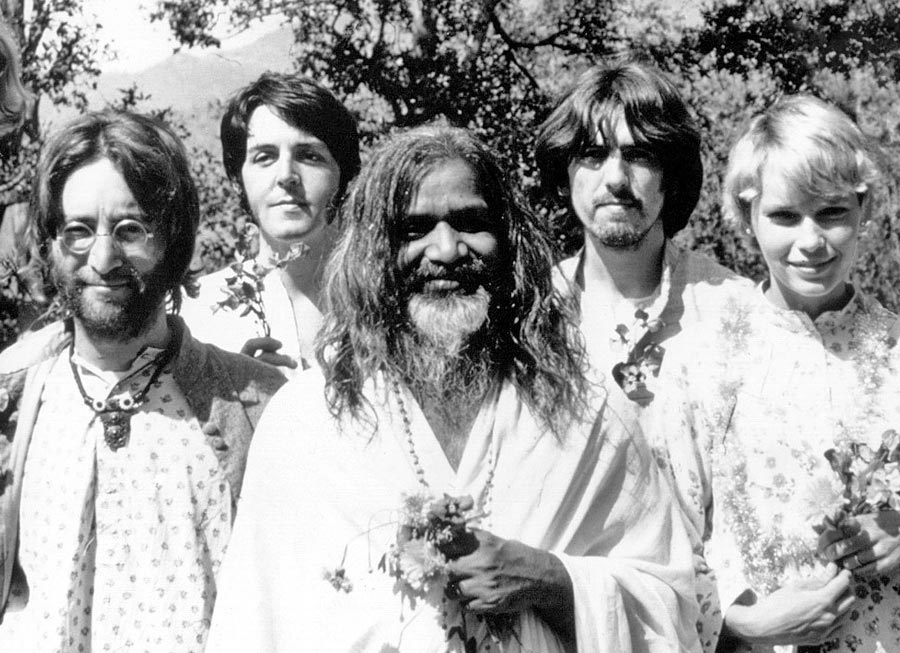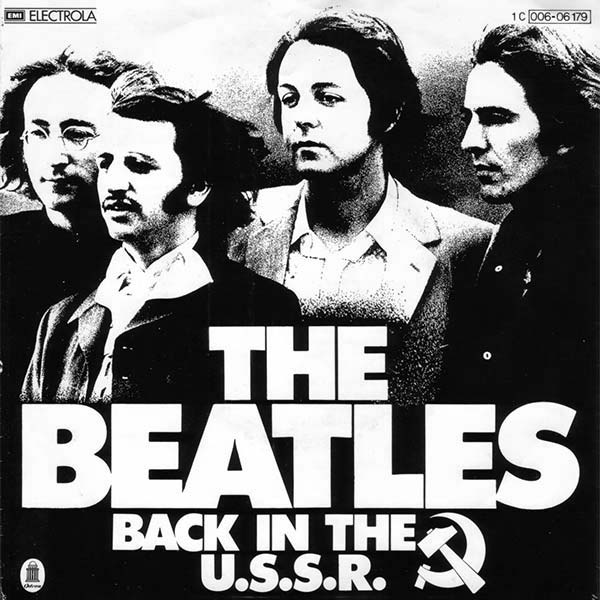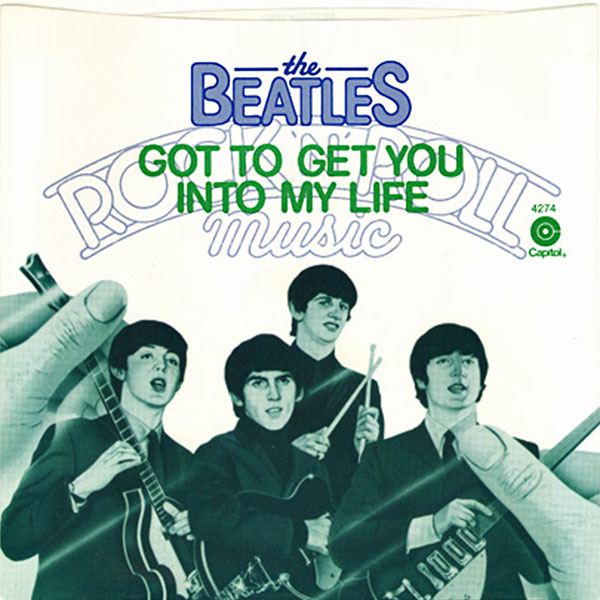Thirty incredibly diverse songs made the albums final cut
John Lennon, Paul McCartney, Maharishi Mahesh Yogi, George Harrison and Mia Farrow in India 1968.
Most of the songs that eventually ended up on The Beatles were conceived during the group’s visit to Rishikesh, India in the spring of 1968. There, they had undertaken a transcendental meditation course with Maharishi Mahesh Yogi. Although the retreat, which had required long periods of meditation, was initially conceived by the as a spiritual respite from all worldly endeavours—a chance, in Lennon’s words, to “get away from everything” [1].
Both Lennon and McCartney had quickly found themselves in songwriting mode, often meeting “clandestinely in the afternoons in each other’s rooms” [2] to review the new work. “Regardless of what I was supposed to be doing,” Lennon later recalled, “I did write some of my best songs there.” [3]
The Beatles left Rishikesh before the end of the course, with Starr and McCartney departing first, and Lennon and Harrison departing together later. According to some reports, Lennon left Rishikesh because he felt personally betrayed by rumors that Maharishi had made sexual advances toward Mia Farrow’s sister Prudence, who attended Transcendental Meditation classes in Rishikesh, India at the same time as the group. Shortly after he decided to leave, Lennon wrote a song called “Maharishi” which included the lyrics, ‘Maharishi you little twat’, the song became “Sexy Sadie”.
According to several authors, Alexis Mardas (aka “Magic Alex” ) deliberately engineered these rumors because he was bent on undermining the Maharishi’s influence over each Beatle. [4] [5] [6] Lennon himself, in a 1980 interview, acknowledged that the Maharishi Mahesh Yogi was the inspiration for the song. “I just called him ‘Sexy Sadie’.” [7]
Ringo watches intently as John and Paul work on a song with their guitars while in India in February of 1968.
Acoustically Speaking
The only western instrument available to the group during their Indian visit was the acoustic guitar, and thus most of the songs on The White Album were written and first performed on that instrument. Some of these songs remained acoustic on The White Album (notably Rocky Raccoon, Blackbird, I Will and Mother Nature’s Son), and were recorded in the studio either solo or by only part of the group.
The Esher Demos
Close to forty new compositions had emerged in Rishikesh, a little more than half of which would be laid down in very rough form at Kinfauns, Harrison’s bungalow home in Esher. In May 1968, John Lennon, Paul McCartney, and George Harrison assembled at Kinfauns. They recorded demos of 27 songs, to be put forward as potential titles for the White Album. Of these songs, 19 eventually found their way onto the album.
Individual Compositions
Although most songs on any given Beatles album are usually credited to the Lennon/McCartney songwriting team, that description is often misleading, and rarely more so than on The White Album. With this album, each of the four members began to showcase the range and depth of his individual songwriting talents. They also began to display styles that would eventually be carried over into their solo careers. Indeed, some songs the individual Beatles were working on during this period were eventually released on solo albums. John Lennon’s “Look at Me” and “Junk” by Paul McCartney are just two of those examples.
Lennon’s contributions to the album are generally more hard-edged lyrically than his previous output, a trend which carried over to his solo career. Examples include his pleas for death on “Yer Blues”, his parodic “Glass Onion”, which mocks fans who read too much into The Beatles’ lyrics (see also Paul is dead), and what may be references to drug addiction in “Happiness Is a Warm Gun” (“I need a fix…”). Lennon’s intensely personal “Julia” may be seen as foreshadowing his later song “Mother” from his first solo album, John Lennon/Plastic Ono ; the political “Revolution 1” begins a pattern of overtly political songs like “Give Peace a Chance” and “John Sinclair”; “Revolution 9” reflects extensive contribution and influence from Ono, another feature of much of Lennon’s solo output. Lennon’s songs on The Beatles embrace a wide array of styles, including blues (“Yer Blues”), acoustic ballads (“Julia” and “Cry Baby Cry”), and rock (“Everybody’s Got Something to Hide Except Me and My “). Lennon would later describe his contributions to the White Album as among his favourite songs recorded with The Beatles.
McCartney’s songs for the album include pop ballads “I Will”, the proto-heavy metal “Helter Skelter”, a Boys homage “Back in the U.S.S.R.”, the up-beat “Ob-La-Di, Ob-La-Da”, and a -hall foxtrot (“Honey Pie”) among others. The soothing, stripped-down “I Will” foreshadowed themes of McCartney’s later solo career.
Harrison’s sparse ballad “Long, Long, Long” is stylistically quite similar to much of his earlier solo output. His songs on The Beatles also includes the lyrically sophisticated “While My Guitar Gently Weeps”, a chronicle of gastronomic excess and dental trauma in “Savoy Truffle”, and a class-driven piece of social commentary in “Piggies”.
Even Starr was given leave to include the first song composed entirely by himself on a Beatles’ album, the country number “Don’t Pass Me By”.
The album is the first by the group not to feature any genuine Lennon-McCartney collaborations; in fact, there would only be one more co-write from the pair in the remainder of the ‘s career (“I’ve Got a Feeling” from the Let It Be album). This new lack of co-operation and focus is reflected in several fragmental, incomplete song ideas that were recorded and released on the album (“Why Don’t We Do It in the ?”, “Wild Honey Pie”, and an officially untitled McCartney snippet at the end of “Cry Baby Cry” often referred to as “Can You Take Me Back”).
On previous albums, such undertakings might have been either abandoned or collaboratively developed before release, but here again, The Beatles represented a change of course for the . The trend continued for the rest of the ‘s recording career: such song fragments were presented by joining them together as a long suite of songs on side two of Abbey .
Although most songs on any given Beatles album are usually credited to the Lennon/McCartney songwriting team, that description is often misleading, and rarely more so than on The White Album. With this album, each of the four members began to showcase the range and depth of his individual songwriting talents. They also began to display styles that would eventually be carried over into their solo careers. Indeed, some songs the individual Beatles were working on during this period were eventually released on solo albums. John Lennon’s “Look at Me” and “Junk” by Paul McCartney are just two of those examples.
Lennon’s contributions to the album are generally more hard-edged lyrically than his previous output, a trend which carried over to his solo career. Examples include his pleas for death on “Yer Blues”, his parodic “Glass Onion”, which mocks fans who read too much into The Beatles’ lyrics (see also Paul is dead), and what may be references to drug addiction in “Happiness Is a Warm Gun” (“I need a fix…”). Lennon’s intensely personal “Julia” may be seen as foreshadowing his later song “Mother” from his first solo album, John Lennon/Plastic Ono ; the political “Revolution 1” begins a pattern of overtly political songs like “Give Peace a Chance” and “John Sinclair”; “Revolution 9” reflects extensive contribution and influence from Ono, another feature of much of Lennon’s solo output. Lennon’s songs on The Beatles embrace a wide array of styles, including blues (“Yer Blues”), acoustic ballads (“Julia” and “Cry Baby Cry”), and rock (“Everybody’s Got Something to Hide Except Me and My “). Lennon would later describe his contributions to the White Album as among his favourite songs recorded with The Beatles.
McCartney’s songs for the album include pop ballads “I Will”, the proto-heavy metal “Helter Skelter”, a Boys homage “Back in the U.S.S.R.”, the up-beat “Ob-La-Di, Ob-La-Da”, and a -hall foxtrot (“Honey Pie”) among others. The soothing, stripped-down “I Will” foreshadowed themes of McCartney’s later solo career.
Harrison’s sparse ballad “Long, Long, Long” is stylistically quite similar to much of his earlier solo output. His songs on The Beatles also includes the lyrically sophisticated “While My Guitar Gently Weeps”, a chronicle of gastronomic excess and dental trauma in “Savoy Truffle”, and a class-driven piece of social commentary in “Piggies”.
Even Starr was given leave to include the first song composed entirely by himself on a Beatles’ album, the country number “Don’t Pass Me By”.
The album is the first by the group not to feature any genuine Lennon-McCartney collaborations; in fact, there would only be one more co-write from the pair in the remainder of the ‘s career (“I’ve Got a Feeling” from the Let It Be album). This new lack of co-operation and focus is reflected in several fragmental, incomplete song ideas that were recorded and released on the album (“Why Don’t We Do It in the ?”, “Wild Honey Pie”, and an officially untitled McCartney snippet at the end of “Cry Baby Cry” often referred to as “Can You Take Me Back”).
On previous albums, such undertakings might have been either abandoned or collaboratively developed before release, but here again, The Beatles represented a change of course for the . The trend continued for the rest of the ‘s recording career: such song fragments were presented by joining them together as a long suite of songs on side two of Abbey .
Patterns and Symmetry
The arrangement of the songs on the White Album follows some patterns and symmetry. For example, Wild Honey Pie is the fifth song from the beginning of the album and Honey Pie is the fifth song from the end. Also, three of the four songs containing animal names in their titles, (Blackbird, Piggies, and Rocky Raccoon) are grouped together. Savoy Truffle, the fourth song from the end of the album, contains a reference to Ob-La-Di, Ob-La-Da, the fourth song from the beginning. In addition, the four songs composed by Harrison are distributed with one on each of the four sides.
Self-Reflection and Change
Many of the songs are personal and self-referencing; for example, “Dear Prudence” was written about Mia Farrow’s sister, Prudence, who attended the transcendental meditation course with The Beatles in Rishikesh. Often she stayed in her room, engaged in Transcendental Meditation. “Julia” was the name of Lennon’s beloved but frequently absent mother, who died during his youth. “While My Guitar Gently Weeps” expresses concern over being “bought and sold,’ a theme in later songs about Harrison himself, such as “Handle with Care”, recorded with The Traveling Wilburys. “Glass Onion” is a Beatles song about Beatles’ songs.
Some of the songs on The Beatles mark important changes in the ’s recording style. Previously, no female voices were to be heard on a Beatles album, but Yoko Ono made her first vocal appearance on this record, adding backing vocals in “Birthday” (along with Pattie Harrison); she also sang backing vocals and a solo line on “The Continuing Story of Bungalow “ and, as noted earlier, was a strong influence on Lennon’s musique concrète piece, “Revolution 9”, an avant-garde sound collage that McCartney initially did not want to include on the album.[8]
Editing Concerns, and Release
‘The Beatles’ was the first Beatles’ album released by Apple Records, as well as their only original double album. Producer George Martin has said that he was against the idea of a double album at the time and suggested to the group that they reduce the number of songs in to form a single album featuring their stronger work, but that the decided against this.[9] Interviewed for the Beatles Anthology, Starr said he now felt it should have been released as two separate albums (that he appropriately named The White Album and The Whiter Album). Harrison felt on reflection that some of the tracks could have been released as B-sides, but “there was a lot of ego in that “. He also supported the idea of the double album, to clear out the backlog of songs the group had at the time. McCartney, by contrast, said it was fine as it was and that its wide variety of songs was a major part of the album’s appeal.[10]
Note: The Beatles (1968) shares the same Nov 22 release date as The Beatles’ second album, With the Beatles (1963).
Compositions Not Included
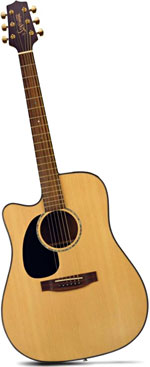 A number of songs were recorded in demo form for possible inclusion but were not incorporated as part of the album. These included Mean Mr. Mustard and Polythene Pam (both of which would be used for the medley on Abbey ); Child of Nature (recorded with drastically different lyrics as Jealous Guy for Lennon’s Imagine),
A number of songs were recorded in demo form for possible inclusion but were not incorporated as part of the album. These included Mean Mr. Mustard and Polythene Pam (both of which would be used for the medley on Abbey ); Child of Nature (recorded with drastically different lyrics as Jealous Guy for Lennon’s Imagine),
Other songs recorded for, but ultimately left off ‘The Beatles’ received significant exposure via bootlegs, notably Harrison’s Circles and Not Guilty (which he would eventually re-record as solo tracks and release on his 1982 album, ‘Gone Troppo’ and 1979 self-titled album, George Harrison respectively) and Lennon’s manic What’s the New Mary Jane.
A number of songs were recorded in demo form for possible inclusion but were not incorporated as part of the album. These included Mean Mr. Mustard and Polythene Pam, both of which would be used for the medley on Abbey Road, Child of NatureJealous Guy for Lennon’s Imagine album. Junk which was released on McCartney’s first solo LP, and Etcetera, a McCartney composition later recorded by the Black Dyke Mills as Thingumybob. Circles, (which Harrison would return to fourteen years later on his 1982 album Gone Troppo), The Long and Winding Road completed in 1969 for the Let It Be LP, Something, which ended up on Abbey Road), and Sour Milk Sea which Harrison gave to friend and Apple artist Jackie Lomax for his first LP.
Other songs recorded for, but ultimately left off The Beatles received significant exposure via bootlegs, notably Harrison’s Circles and Not Guilty which he would eventually re-record as solo tracks and release on his 1982 album, Gone Troppo and 1979 self-titled album, George Harrison respectively, and Lennon’s manic What’s the New Mary Jane.
The Singles
Although Hey Jude was not intended to be included on any LP release, it was recorded during the White Album sessions and was released as a stand-alone single before the release of The Beatles album. Hey Jude’s B-side, Revolution, was an alternate version of the album’s Revolution 1. Lennon had wanted the original version of Revolution 1 to be released as a single, but the other three Beatles objected on the grounds that it was too slow. A new, faster version, with heavily distorted guitar and a high-energy keyboard solo from Nicky Hopkins was recorded.
The resulting release — Hey Jude on side A and Revolution, with the faster version on side B emerged as the first release on the Beatles’ new Apple Records label, and went on to become the best selling single of their career.
Four tracks from the White Album were released on two American and one British single almost eight years after the original album was released. In the summer of 1976, to promote the compilation album, Rock ‘n’ , EMI’s Parlophone label in the UK and its Capitol label in the US each released a single that contained A and B-sides that appeared on the compilation album. In Britain, Parlophone issued Back in the U.S.S.R. backed with Twist and Shout, while in the US Capitol released Got To Get You Into My Life backed with Helter Skelter on May 31, 1976.
The singles were successful, with Got to Get You into My Life hitting No. 7 on the Billboard Hot 100 chart, the Beatles’ last top ten US hit until their 1995 release Free as a . Back in the U.S.S.R. hit No. 18 on the New Musical Express chart in Britain. Both records also helped sell Rock ‘n’ , which hit No. 2 in the United States and No. 10 in the UK. With the unexpected success of the singles from the compilation album, Capitol followed-up Got To Get You Into My Life with the release of another single in November of 1976 which didn’t appear on the Rock ‘n’ album, but on the White Album, Ob-La-Di, Ob-La-Da.
Capitol Records, instead of taking two more tracks from the Rock ‘n’ album, selected two White Album tracks Ob-La-Di, Ob-La-Da as the A-Side, and Julia as the B-Side. The Ob-La-Di, Ob-La-Da single was sold in an individually-numbered white picture sleeve that mimicked the design of the original album. It did not duplicate the success of its predecessor, stalling out at No. 49 on Billboard Hot 100. Ob-La-Di, Ob-La-Da was originally released as a single in 1968 in many countries, but not in the United Kingdom, nor in the United States until 1976.
FOOTNOTES:
[1] Anthology, page 281
[2] , Bob (2006). The Beatles: The Biography. Little Brown and Company. ISBN 0316013315, page 752
[3] Anthology, page 283
[4] Brown, Peter; Steven Gaines (2002). The Love You Make: An Insider’s Story of the Beatles. Penguin Group Inc. ISBN 0451207351
[5] , Bob (2006). The Beatles: The Biography. Little Brown and Company. ISBN 0316013315
[6] Lennon, Cynthia (1978). A Twist of Lennon. Star Books. ISBN 0352301961
[7] Sheff, David (1981). The Playboy Interviews with John Lennon & Yoko Ono. Playboy Press. ISBN not listed.
[8] The Beatles Anthology (1995
[9] The Beatles Anthology DVD features an interview with Martin confirming this discussion.
[10] The Beatles (2003). The Beatles Anthology (DVD). Apple Records. ASIN: B00008GKEG.
Thirty incredibly diverse songs made the albums final cut
John Lennon, Paul McCartney, Maharishi Mahesh Yogi, George Harrison and Mia Farrow in India 1968.
Most of the songs that eventually ended up on “The Beatles” were conceived during the group’s visit to Rishikesh, India in the spring of 1968. There, they had undertaken a transcendental meditation course with Maharishi Mahesh Yogi. Although the retreat, which had required long periods of meditation, was initially conceived by the as a spiritual respite from all worldly endeavours—a chance, in Lennon’s words, to “get away from everything” [1].
Both Lennon and McCartney had quickly found themselves in songwriting mode, often meeting “clandestinely in the afternoons in each other’s rooms” [2] to review the new work. “Regardless of what I was supposed to be doing,” Lennon later recalled, “I did write some of my best songs there.” [3]
The Beatles left Rishikesh before the end of the course, with Starr and McCartney departing first, and Lennon and Harrison departing together later. According to some reports, Lennon left Rishikesh because he felt personally betrayed by rumors that Maharishi had made sexual advances toward Mia Farrow’s sister Prudence, who attended Transcendental Meditation classes in Rishikesh, India at the same time as the group. Shortly after he decided to leave, Lennon wrote a song called “Maharishi” which included the lyrics, ‘Maharishi you little twat’, the song became “Sexy Sadie”.
According to several authors, Alexis Mardas (aka “Magic Alex” ) deliberately engineered these rumors because he was bent on undermining the Maharishi’s influence over each Beatle. [4] [5] [6] Lennon himself, in a 1980 interview, acknowledged that the Maharishi Mahesh Yogi was the inspiration for the song. “I just called him ‘Sexy Sadie’.” [7]
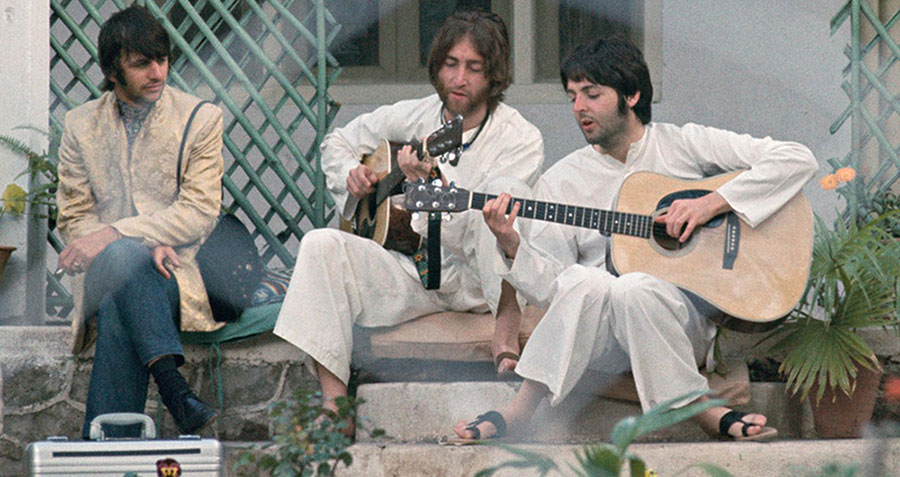
Ringo watches intently as John and Paul work on a song with their guitars while in India in Feb. of 1968.
Acoustically Speaking
The only western instrument available to the group during their Indian visit was the acoustic guitar, and thus most of the songs on The White Album were written and first performed on that instrument. Some of these songs remained acoustic on The White Album (notably Rocky Raccoon, Blackbird, I Will and Mother Nature’s Son), and were recorded in the studio either solo or by only part of the group.
The Esher Demos
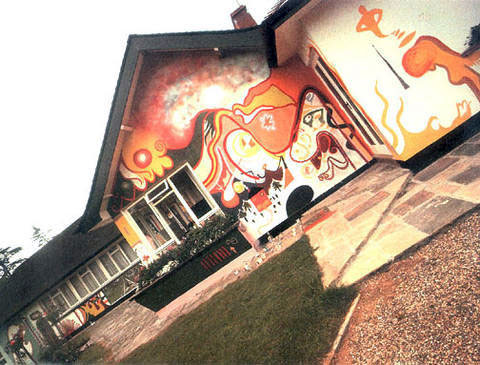
Kinfauns was from 1964 to 1970 the home of George Harrison. The bungalow has since been demolished, and another built in its place.
Close to forty new compositions had emerged in Rishikesh, a little more than half of which would be laid down in very rough form at Kinfauns, Harrison’s bungalow home in Esher. In May 1968, John Lennon, Paul McCartney, and George Harrison assembled at Kinfauns. They recorded demos of 27 songs, to be put forward as potential titles for the White Album. Of these songs, 19 eventually found their way onto the album.
Individual Compositions
Although most songs on any given Beatles album are usually credited to the Lennon/McCartney songwriting team, that description is often misleading, and rarely more so than on The White Album. With this album, each of the four members began to showcase the range and depth of his individual songwriting talents. They also began to display styles that would eventually be carried over into their solo careers. Indeed, some songs the individual Beatles were working on during this period were eventually released on solo albums. John Lennon’s “Look at Me” and “Junk” by Paul McCartney are just two of those examples.
Lennon’s contributions to the album are generally more hard-edged lyrically than his previous output, a trend which carried over to his solo career. Examples include his pleas for death on “Yer Blues”, his parodic “Glass Onion”, which mocks fans who read too much into The Beatles’ lyrics (see also Paul is dead), and what may be references to drug addiction in “Happiness Is a Warm Gun” (“I need a fix…”). Lennon’s intensely personal “Julia” may be seen as foreshadowing his later song “Mother” from his first solo album, John Lennon/Plastic Ono ; the political “Revolution 1” begins a pattern of overtly political songs like “Give Peace a Chance” and “John Sinclair”; “Revolution 9” reflects extensive contribution and influence from Ono, another feature of much of Lennon’s solo output. Lennon’s songs on The Beatles embrace a wide array of styles, including blues (“Yer Blues”), acoustic ballads (“Julia” and “Cry Baby Cry”), and rock (“Everybody’s Got Something to Hide Except Me and My “). Lennon would later describe his contributions to the White Album as among his favourite songs recorded with The Beatles.
McCartney’s songs for the album include pop ballads “I Will”, the proto-heavy metal “Helter Skelter”, a Boys homage “Back in the U.S.S.R.”, the up-beat “Ob-La-Di, Ob-La-Da”, and a -hall foxtrot (“Honey Pie”) among others. The soothing, stripped-down “I Will” foreshadowed themes of McCartney’s later solo career.
Harrison’s sparse ballad “Long, Long, Long” is stylistically quite similar to much of his earlier solo output. His songs on The Beatles also includes the lyrically sophisticated “While My Guitar Gently Weeps”, a chronicle of gastronomic excess and dental trauma in “Savoy Truffle”, and a class-driven piece of social commentary in “Piggies”.
Even Starr was given leave to include the first song composed entirely by himself on a Beatles’ album, the country number “Don’t Pass Me By”.
The album is the first by the group not to feature any genuine Lennon-McCartney collaborations; in fact, there would only be one more co-write from the pair in the remainder of the ‘s career (“I’ve Got a Feeling” from the Let It Be album). This new lack of co-operation and focus is reflected in several fragmental, incomplete song ideas that were recorded and released on the album (“Why Don’t We Do It in the ?”, “Wild Honey Pie”, and an officially untitled McCartney snippet at the end of “Cry Baby Cry” often referred to as “Can You Take Me Back”).
On previous albums, such undertakings might have been either abandoned or collaboratively developed before release, but here again, The Beatles represented a change of course for the . The trend continued for the rest of the ‘s recording career: such song fragments were presented by joining them together as a long suite of songs on side two of Abbey .
Although most songs on any given Beatles album are usually credited to the Lennon/McCartney songwriting team, that description is often misleading, and rarely more so than on The White Album. With this album, each of the four members began to showcase the range and depth of his individual songwriting talents. They also began to display styles that would eventually be carried over into their solo careers. Indeed, some songs the individual Beatles were working on during this period were eventually released on solo albums. John Lennon’s “Look at Me” and “Junk” by Paul McCartney are just two of those examples.
Lennon’s contributions to the album are generally more hard-edged lyrically than his previous output, a trend which carried over to his solo career. Examples include his pleas for death on “Yer Blues”, his parodic “Glass Onion”, which mocks fans who read too much into The Beatles’ lyrics (see also Paul is dead), and what may be references to drug addiction in “Happiness Is a Warm Gun” (“I need a fix…”). Lennon’s intensely personal “Julia” may be seen as foreshadowing his later song “Mother” from his first solo album, John Lennon/Plastic Ono ; the political “Revolution 1” begins a pattern of overtly political songs like “Give Peace a Chance” and “John Sinclair”; “Revolution 9” reflects extensive contribution and influence from Ono, another feature of much of Lennon’s solo output. Lennon’s songs on The Beatles embrace a wide array of styles, including blues (“Yer Blues”), acoustic ballads (“Julia” and “Cry Baby Cry”), and rock (“Everybody’s Got Something to Hide Except Me and My “). Lennon would later describe his contributions to the White Album as among his favourite songs recorded with The Beatles.
McCartney’s songs for the album include pop ballads “I Will”, the proto-heavy metal “Helter Skelter”, a Boys homage “Back in the U.S.S.R.”, the up-beat “Ob-La-Di, Ob-La-Da”, and a -hall foxtrot (“Honey Pie”) among others. The soothing, stripped-down “I Will” foreshadowed themes of McCartney’s later solo career.
Harrison’s sparse ballad “Long, Long, Long” is stylistically quite similar to much of his earlier solo output. His songs on The Beatles also includes the lyrically sophisticated “While My Guitar Gently Weeps”, a chronicle of gastronomic excess and dental trauma in “Savoy Truffle”, and a class-driven piece of social commentary in “Piggies”.
Even Starr was given leave to include the first song composed entirely by himself on a Beatles’ album, the country number “Don’t Pass Me By”.
The album is the first by the group not to feature any genuine Lennon-McCartney collaborations; in fact, there would only be one more co-write from the pair in the remainder of the ‘s career (“I’ve Got a Feeling” from the Let It Be album). This new lack of co-operation and focus is reflected in several fragmental, incomplete song ideas that were recorded and released on the album (“Why Don’t We Do It in the ?”, “Wild Honey Pie”, and an officially untitled McCartney snippet at the end of “Cry Baby Cry” often referred to as “Can You Take Me Back”).
On previous albums, such undertakings might have been either abandoned or collaboratively developed before release, but here again, The Beatles represented a change of course for the . The trend continued for the rest of the ‘s recording career: such song fragments were presented by joining them together as a long suite of songs on side two of Abbey .
Patterns and Symmetry
The arrangement of the songs on the White Album follows some patterns and symmetry. For example, Wild Honey Pie is the fifth song from the beginning of the album and Honey Pie is the fifth song from the end. Also, three of the four songs containing animal names in their titles, (Blackbird, Piggies, and Rocky Raccoon) are grouped together. Savoy Truffle, the fourth song from the end of the album, contains a reference to Ob-La-Di, Ob-La-Da, the fourth song from the beginning. In addition, the four songs composed by Harrison are distributed with one on each of the four sides.
Self-Reflection and Change
Many of the songs are personal and self-referencing; for example, “Dear Prudence” was written about Mia Farrow’s sister, Prudence, who attended the transcendental meditation course with The Beatles in Rishikesh. Often she stayed in her room, engaged in Transcendental Meditation. “Julia” was the name of Lennon’s beloved but frequently absent mother, who died during his youth. “While My Guitar Gently Weeps” expresses concern over being “bought and sold,’ a theme in later songs about Harrison himself, such as “Handle with Care”, recorded with The Traveling Wilburys. “Glass Onion” is a Beatles song about Beatles’ songs.
Some of the songs on The Beatles mark important changes in the ’s recording style. Previously, no female voices were to be heard on a Beatles album, but Yoko Ono made her first vocal appearance on this record, adding backing vocals in “Birthday” (along with Pattie Harrison); she also sang backing vocals and a solo line on “The Continuing Story of Bungalow “ and, as noted earlier, was a strong influence on Lennon’s musique concrète piece, “Revolution 9”, an avant-garde sound collage that McCartney initially did not want to include on the album.[8]
Editing Concerns, and Release
‘The Beatles’ was the first Beatles’ album released by Apple Records, as well as their only original double album. Producer George Martin has said that he was against the idea of a double album at the time and suggested to the group that they reduce the number of songs in to form a single album featuring their stronger work, but that the decided against this.[9] Interviewed for the Beatles Anthology, Starr said he now felt it should have been released as two separate albums (that he appropriately named The White Album and The Whiter Album). Harrison felt on reflection that some of the tracks could have been released as B-sides, but “there was a lot of ego in that “. He also supported the idea of the double album, to clear out the backlog of songs the group had at the time. McCartney, by contrast, said it was fine as it was and that its wide variety of songs was a major part of the album’s appeal.[10]
Note: The Beatles (1968) shares the same Nov 22 release date as The Beatles’ second album, With the Beatles (1963).
Compositions Not Included
A number of songs were recorded in demo form for possible inclusion but were not incorporated as part of the album. These included Mean Mr. Mustard and Polythene Pam, both of which would be used for the medley on Abbey Road, Child of NatureJealous Guy for Lennon’s Imagine album. Junk which was released on McCartney’s first solo LP, and Etcetera, a McCartney composition later recorded by the Black Dyke Mills as Thingumybob. Circles, (which Harrison would return to fourteen years later on his 1982 album Gone Troppo), The Long and Winding Road completed in 1969 for the Let It Be LP, Something, which ended up on Abbey Road), and Sour Milk Sea which Harrison gave to friend and Apple artist Jackie Lomax for his first LP.
Other songs recorded for, but ultimately left off The Beatles received significant exposure via bootlegs, notably Harrison’s Circles and Not Guilty which he would eventually re-record as solo tracks and release on his 1982 album, Gone Troppo and 1979 self-titled album, George Harrison respectively, and Lennon’s manic What’s the New Mary Jane.
The Singles
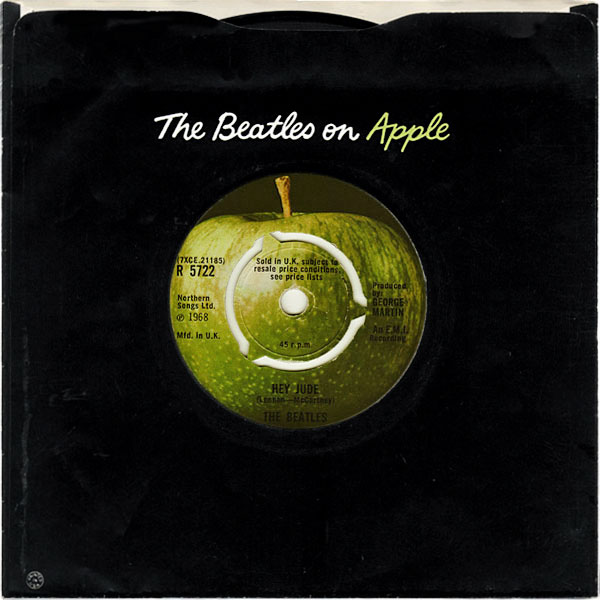
Although Hey Jude was not intended to be included on any LP release, it was recorded during the White Album sessions and was released as a stand-alone single before the release of The Beatles album. Hey Jude’s B-side, Revolution, was an alternate version of the album’s Revolution 1. Lennon had wanted the original version of Revolution 1 to be released as a single, but the other three Beatles objected on the grounds that it was too slow. A new, faster version, with heavily distorted guitar and a high-energy keyboard solo from Nicky Hopkins was recorded.
The resulting release — Hey Jude on side A and Revolution, with the faster version on side B emerged as the first release on the Beatles’ new Apple Records label, and went on to become the best selling single of their career.
The resulting release — Hey Jude on side A and Revolution, with the faster version on side B emerged as the first release on the Beatles’ new Apple Records label, and went on to become the best selling single of their career.
Four tracks from the White Album were released on two American and one British single almost eight years after the original album was released. In the summer of 1976, to promote the compilation album, Rock ‘n’ , EMI’s Parlophone label in the UK and its Capitol label in the US each released a single that contained A and B-sides that appeared on the compilation album. In Britain, Parlophone issued Back in the U.S.S.R. backed with Twist and Shout, while in the US Capitol released Got To Get You Into My Life backed with Helter Skelter on May 31, 1976.
The singles were successful, with Got to Get You into My Life hitting No. 7 on the Billboard Hot 100 chart, the Beatles’ last top ten US hit until their 1995 release Free as a . Back in the U.S.S.R. hit No. 18 on the New Musical Express chart in Britain. Both records also helped sell Rock ‘n’ , which hit No. 2 in the United States and No. 10 in the UK. With the unexpected success of the singles from the compilation album, Capitol followed-up Got To Get You Into My Life with the release of another single in November of 1976 which didn’t appear on the Rock ‘n’ album, but on the White Album, Ob-La-Di, Ob-La-Da.
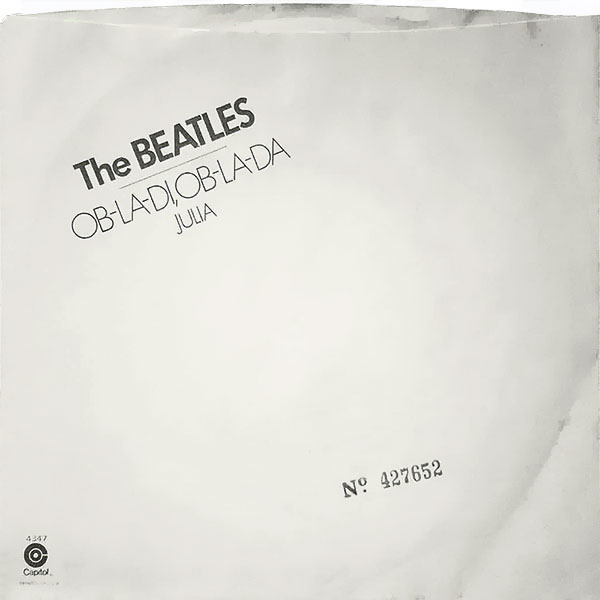
Capitol Records, instead of taking two more tracks from the Rock ‘n’ album, selected two White Album tracks Ob-La-Di, Ob-La-Da as the A-Side, and Julia as the B-Side. The Ob-La-Di, Ob-La-Da single was sold in an individually-numbered white picture sleeve that mimicked the design of the original album. It did not duplicate the success of its predecessor, stalling out at No. 49 on Billboard Hot 100. Ob-La-Di, Ob-La-Da was originally released as a single in 1968 in many countries, but not in the United Kingdom, nor in the United States until 1976.
FOOTNOTES:
[1] Anthology, page 281
[2] , Bob (2006). The Beatles: The Biography. Little Brown and Company. ISBN 0316013315, page 752
[3] Anthology, page 283
[4] Brown, Peter; Steven Gaines (2002). The Love You Make: An Insider’s Story of the Beatles. Penguin Group Inc. ISBN 0451207351
[5] , Bob (2006). The Beatles: The Biography. Little Brown and Company. ISBN 0316013315
[6] Lennon, Cynthia (1978). A Twist of Lennon. Star Books. ISBN 0352301961
[7] Sheff, David (1981). The Playboy Interviews with John Lennon & Yoko Ono. Playboy Press. ISBN not listed.
[8] The Beatles Anthology (1995
[9] The Beatles Anthology DVD features an interview with Martin confirming this discussion.
[10] The Beatles (2003). The Beatles Anthology (DVD). Apple Records. ASIN: B00008GKEG.




